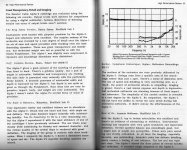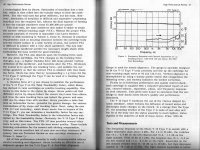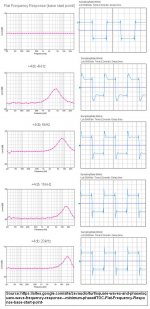No, the ringing is on the test record, PRIMARILY.
No. We've been through that one a few times, no need to take that argument apart once again.
No, the ringing is on the test record, PRIMARILY. The 'ringing' is ULTRASONIC in any case.
You see Mr. Curl, the same problem again.
These spectrums you have shown a few times representing cymbal crashes as reproduced by some cartridges.
The question was, what the original signal looks like?
How one can judge on the reproduction quality if he doesn’t know the form of the signal before the reproducing cartridge?
George
You see Mr. Curl, the same problem again.
These spectrums you have shown a few times representing cymbal crashes as reproduced by some cartridges.
The question was, what the original signal looks like?
How one can judge on the reproduction quality if he doesn’t know the form of the signal before the reproducing cartridge?
For the case of the square wave, run the record at a different speed.
For the case of the square wave, run the record at a different speed.
Excellent! (Now I need an asynchronous motor to run it through a variac)
This way, one can study the “signature” of the mechanical parts of the cartridge.
There is only one problem I think.
Vinyl is viscoelastic.
Along with speed change, needle tip will face different vinyl behavior (dynamic reaction).
George
This pretty well goes also for CD, digital in general, even decent rate lossy. If one has a clear picture in one's mind of how good the replay of a certain recording can be, then all the excuses in the world for why the medium is inherently limited, crippled, that some technical aspect of it won't allow "high end" sound to emerge are easily discarded.We sometimes blame the medium, when it fact it's just bad gear. At the shop we still have an object of fetish, a Sony Pro SVO-5800 S-VHS deck that cost several thousand dollars new. It's simply amazing. Used as a record/playback deck it rivals DVD quality. Even playing back commercially recorded tapes it looks better than you ever thought VHS could.
VHS is not a wonderful medium, but done right, it looks better than you ever thought it could. Much better. That comes at a high price, tho.
The hifi show sound didn't scream in the conventional sense, typically it was just lacklustre, dreary, lifeless - the sort of sound where you couldn't be bothered turning up the volume, because what would be the point - you could easily hear that there wasn't anything worth listening to in the sound ... . Surprisingly, the vinyl playback was the worst offender - my friend's very low cost analogue unit was vastly superior in the key areas. There were some real surprises: Naim, which the analogue setup I just mentioned uses for speakers and amplification, was dreadful ... the worst sort of 80's hifi shop sound, everything that could be wrong, was: shouty, cluttered, almost PA type sound.
Last edited:
If its on the disk run at 1/2 speed 16 rpm and the ringing will be obvious and clearly at a different frequency.
Exactly right. And if you run it at 45rpm, the ringing will be at about 1.4 times the frequency at 33 rpm- if it's on the record. If the ringing doesn't change frequency, you're looking at cartridge resonance.
Well, if anybody has the test record, we should check it out. I don't have it anymore, but I was told that the test 'triangle wave' that differentiates into a square wave was recorded at 1/2 speed or less. This would make sense with an older Westrex or similar recording head, if they they could be adjusted for maximum bandwidth by changing the feedback on the head. this would normally cause a bump at high frequency, about 40+kHz.
I am willing to go with solid proof that a nearly perfect square wave could be generated by any 'nearly perfect' phono cartridge, but I have never found it. I have only found extreme rolloff in older Shure, Empire, and other similar cartridges, because they could not reproduce 40KHz or more, so the square wave looked pretty smooth back in the 1960's or so. My own extended sweep frequency response measurements showed a slight rise, perhaps 3dB at 40kHz or so for Supex and similar phono cartridges. 30kHz for EMT. Almost completely flat from 20-20KHz, except for scanning losses that were not completely covered by early MC cartridges, except for EMT that was almost ruler flat 20-20KHz. We used an extended response Ortofon test record for our tests. Show me different results somebody, if you can. I have already done a number of measurements showing the trend.
I am willing to go with solid proof that a nearly perfect square wave could be generated by any 'nearly perfect' phono cartridge, but I have never found it. I have only found extreme rolloff in older Shure, Empire, and other similar cartridges, because they could not reproduce 40KHz or more, so the square wave looked pretty smooth back in the 1960's or so. My own extended sweep frequency response measurements showed a slight rise, perhaps 3dB at 40kHz or so for Supex and similar phono cartridges. 30kHz for EMT. Almost completely flat from 20-20KHz, except for scanning losses that were not completely covered by early MC cartridges, except for EMT that was almost ruler flat 20-20KHz. We used an extended response Ortofon test record for our tests. Show me different results somebody, if you can. I have already done a number of measurements showing the trend.
Well, if anybody has the test record, we should check it out.
I do. This was our tool for evaluating cartridges and how the EPC100 got "discovered" in the US. Read the Stereophile reviews for the story (their reviewer was a good friend of ours)- it ended up being their reference cartridge, replacing, yes, the V-15.
George, you misunderstand what I was testing for with my bandwidth measurements of MISTRACKING phono cartridges. I deliberately mistracked each cartridge, by finding an almost 'impossible' to track passage on a Sheffield direct disc recording. It was the MISTRACKING that generates the bandwidth, up to 500KHZ, with mistracking. I did NOT have to try hard to make the cartridges that I used at the time to mistrack, they did it within the range of their recommended tracking force with the passage I selected. Once the stylus leaves the groove, then it must come back down and 'crash' on the vinyl surface. The bandwidth then depends on the 'intrinsic' bandwidth of the playback cartridge with both mechanical and electrical resonances, some within the audio bandwidth, but most MC's outside the audio bandwidth. My concern was the EFFECT of such a broadband signal on a phono stage designed with only 20-20kHz in mind, and no more. I believe that I made my point 35 years ago. What have you guys done lately?
Attachments
George, you misunderstand what I was testing for with my bandwidth measurements of MISTRACKING phono cartridges
Thank you M. Curl.
Now I understand what you were doing.
I am afraid that they were many variables in the mix.
It seems that many things are predictable and explainable by theory (which I didn’t know).
Attached, some telling FR/SQW
Source: https://sites.google.com/site/zevaudio/turt/square-waves-and-phase/square-wave-frequency-response---minimum-phase#TOC-Flat-Frequency-Response-base-start-point-
If you will read this https://sites.google.com/site/zevaudio/turt/cartridge-comparison-list/shure-v15v
You will find a way to separate electrical from mechanical resonances, at least applicable for MM cartridges.
In some of the FR plots shown below, you will find cartridges with HF peaking continuing raising past 20kHz https://sites.google.com/site/zevaudio/turt/cartridge-comparison-list
George
Attachments
Last edited:
Scott, I think A/D is for audio far more important than cartridges.
Is it possible to explain what you mean by “some pretty bad AD/DA chips”.
Does it have to do with multibit/one bit decision or what?
George
PS. Who is TL ?
The performance when reproducing computer generated tones. I still have one vintage external DA from MOTU that will play a 24 bit sinewave from Audition (so the source has virtually no distortion) with very low THD and artifacts, better than the EMU0204. The EDIROL was even better.
I actually have several recent devices that won't reproduce a digital sine wave that hits +-32,767 in 16bit.
Scott can probably provide more insight but I think ADI has effectively exited the premium audio ADC market. The current products are less focused on ultimate performance. The current serious players for ADC are AKM, Crystal, TI and a few boutique houses. None of the major players have released new stuff in the last 10 years it seems. From what I have been able to determine AKM has many of the pro and semipro sockets. The AKM 5394A is the best performing ADC I have found but I'm sure someone here will tell me why its no good.
I have not looked under the hood, I can't disparage by brand yet.
A very good analogy, Scott. We sometimes blame the medium, when it fact it's just bad gear. At the shop we still have an object of fetish, a Sony Pro SVO-5800 S-VHS deck that cost several thousand dollars new. It's simply amazing. Used as a record/playback deck it rivals DVD quality. Even playing back commercially recorded tapes it looks better than you ever thought VHS could.
VHS is not a wonderful medium, but done right, it looks better than you ever thought it could. Much better. That comes at a high price, tho.
I don't know if you ever saw them making tapes, 1X speed in a room full of Panasonic NV7200's. Remember $50 - $75 for a new film on VHS? That machine could be picked up for $1500 or so, quartz locked capstan very low chroma noise.
Scott, I'd be happy to run a Letter to the Editor....
jan
Jan, the author would have to explain figures 4 and 5 (at least provide the equation for each) before it would be worth a discussion. I'm working on an article for the next issue, a sort of digital take on Gary Galo's article. I helped one of open source folks out on biquad digital filters for RIAA and it was an eye opener. There are several small (some DIY) DSP platforms that run biquad filters for crossovers/equalizers no reason they can't do RIAA or anyone of the other choices. To my chagrin the Behringer 24/96 does not seem to support arbitrary entry of the z domain poles and zeros.
Believe it or not, it is not rocket science. PS - I'm glad you got both Dick and Erik to contribute, now we need to work on Barrie
Last edited:
Yes, pretty much. We had a room full of VHS dup machines, the auto-loaders. Each machine did 4 tapes, IIRC. I think they were JVC. Very well built, good, solid, well engineered. It was impressive to see and hear 200 tapes load at once! We soon discovered it impressed the ladies, so they'd get a night time tour.I don't know if you ever saw them making tapes, 1X speed in a room full of Panasonic NV7200's.
Back in the early 70s I used to buy music on cassette from Columbia House. They were uniformly awful, and I didn't understand why. If I recorded an LP on my cassette deck it sounded pretty darn good, way better than the prerecorded tapes I bought. That was when I learned about high speed tape duplication and cheap as possible tape and shells.
Just because something can be good, doesn't mean it will be.
- Status
- Not open for further replies.
- Home
- Member Areas
- The Lounge
- John Curl's Blowtorch preamplifier part II



